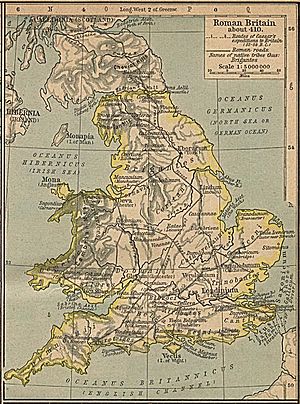Valentia (Roman Britain) facts for kids

Valentia was likely one of the Roman provinces in Britain during later Roman times. Its name means "Land of Valens" in Latin, honoring the Roman emperor Valens. We don't know for sure where it was, what its main city was, or if it even existed exactly as described.
Valentia wasn't mentioned in an old Roman list from around AD 312. This suggests it was probably created later, perhaps from parts of other provinces. Some experts think Valentia was a new name for the whole group of Roman provinces in Britain. However, another old list, the Notitia Dignitatum, says Valentia was a separate province with a high-ranking governor, just like Maxima Caesariensis and other provinces.
People have different ideas about where Valentia was located. Some think it was in Wales, with its capital city at Chester. Others suggest it was in Cumbria, south of Hadrian's Wall, with Carlisle as its capital. Another idea is that it was the land between the Antonine Wall and Hadrian's Wall. However, many modern experts don't think this last idea is likely because there's no strong evidence that the Romans re-occupied southern Scotland in the 300s AD.
Contents
How Valentia Got Its Name
The name Valentia most likely honored Valens, who was the Roman emperor in the Eastern part of the empire. However, some people also believe it might have honored Valentinian I, another emperor.
Some researchers, like S. H. Rosenbaum, who think Valentia was in northern Britain, also believe its name might have been a clever play on the Latin word vallum, which means "wall." This would make sense if the province was near a big wall like Hadrian's Wall.
How Valentia Was Formed
The Roman historian Ammianus Marcellinus wrote about Valentia. He explained that after a big problem called the Great Conspiracy in AD 367, a Roman general named Count Theodosius helped fix things in Britain.
The Great Conspiracy was a time when northern and western Britain were taken over by enemies, and Germanic tribes also attacked Roman shores. In AD 369, Theodosius successfully recovered the lost areas. Ammianus wrote that Theodosius:
- "...restored cities and fortresses... and so completely recovered the province which had yielded subjection to the enemy, that through his agency it was again brought under the authority of its legitimate ruler, and from that time forth was called Valentia, by desire of the emperor, as a memorial of his success."
This means that Valentia was likely a province that was recovered and then renamed to celebrate Emperor Valens's success.
The Notitia Dignitatum (List of Offices) also lists Valentia's governor separately from the other four known British provinces. This suggests that Valentia might have been a new province created after an earlier list (the Verona List) was made.
Where Was Valentia Located?
The Notitia Dignitatum also mentions two groups of Roman soldiers in Britain. One group guarded the eastern coast, and the other protected the northwest coast and the forts along Hadrian's Wall.
Experts who believe Valentia was in Cumbria (northern England) point to changes in the old texts. They suggest that this area was badly affected during the Great Conspiracy. This would make it a good candidate for Theodosius to reconquer and establish a new command.
Why Valentia Was Special
Ammianus also noted that the province was named "as if celebrating a minor triumph" (velut ovans). A "triumph" was a big parade and celebration for a Roman general's victory. A "minor triumph" was a smaller celebration, usually for less spectacular victories, like putting down a slave revolt. It was unusual for defeating a barbarian army.
One idea for this "minor triumph" is that rebellious Roman soldiers or even governors might have been involved in the Great Conspiracy. Full triumphs were never held for victories over Roman citizens. Theodosius was quite lenient with some of the people involved in the rebellion, which suggests there might have been widespread unhappiness among Romans at the time.
Later Ideas About Valentia
Over time, different people had different ideas about where Valentia was.
Gerald of Wales, a writer from the 1100s, thought Valentia was in Scotland. He even suggested its main church (and thus its capital) was at St Andrews, which is unlikely for a Roman province.
Later, William Camden, a famous English historian from the 1500s, looked at Ammianus's writings. He thought Valentia was the northern part of another province, Maxima Caesariensis, which he placed around Eboracum (York).
This idea became very popular after a book called The Description of Britain appeared in the 1740s. This book, written by Charles Bertram, was actually a fake. It claimed Valentia was located between the two Roman walls (Hadrian's Wall and the Antonine Wall). It even named the area north of the Antonine Wall as a separate province called Vespasiana. However, by the mid-1800s, experts realized Bertram's book was a fake.
Today, the exact location and nature of Valentia are still debated by historians, making it one of the mysteries of Roman Britain.
Images for kids
-
The traditional arrangement of the late Roman provinces after Camden, placing Valentia between the walls



